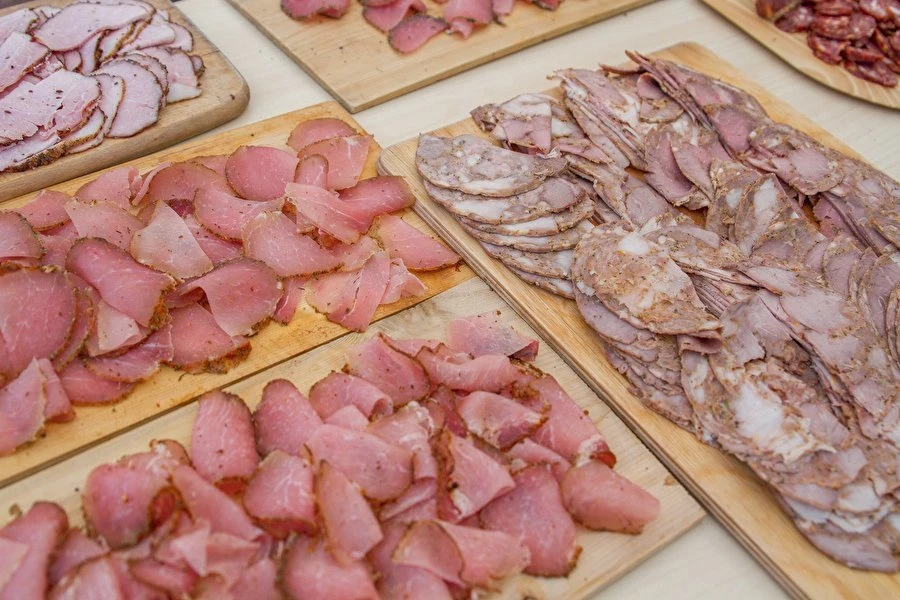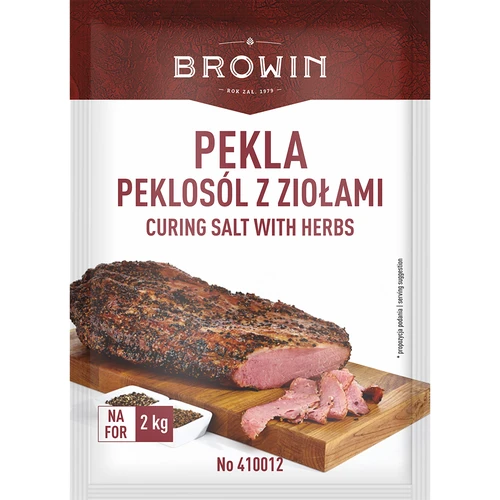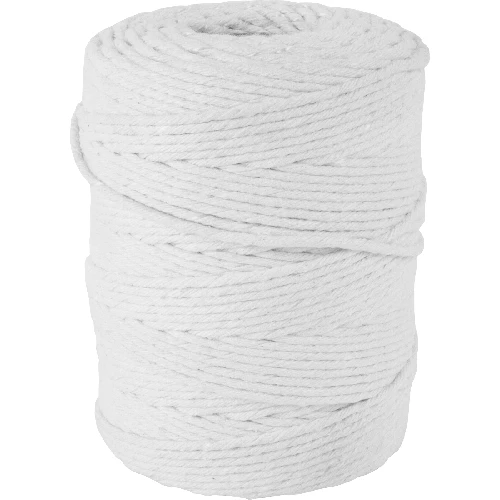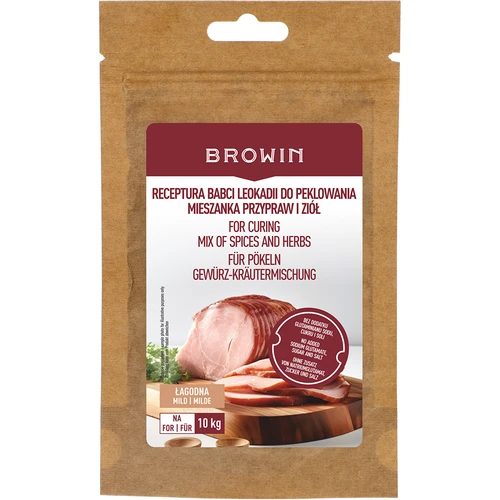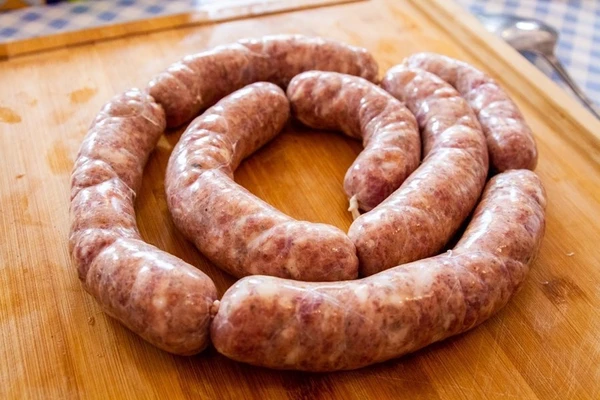The homemade cold meat clearly differs in flavour from that available in supermarkets and meat stores. If you value selecting the right ingredients, you want to avoid artificial additives, and you are interested in full flavour adjusted to your preferences – try making your own cold meat at home. It is not that difficult at all! A bit of motivation, proper equipment, and high quality meat are enough to conjure delicious and aromatic sausages, hams, pates, and stews at home. If you want to learn how to get prepared to start you adventure with cold meat making, consider yourself invited to read our post where we divulge the details and the secrets of our experts!
PREPARATION OF HOMEMADE COLD MEAT AND SMOKED MEAT CAN BE DIVIDED INTO SEVERAL STAGES:
Curing
The first stage of preparing meat for further processing is curing. It is not entirely necessary, but this process is in itself a meat preservation method and thanks to it the meat has a pink colour, is tender, and remains suitable for consumption longer. The foundation of any good curing brine is saltpetre and table salt. It is also possible to use curing salt or potassium saltpetre.
At the first stage of curing, the nitrate ions originating from the saltpetre are reduced to nitrites under the influence of enzymes in meat. Next, these ions react with myoglobin (the protein responsible for the unstable pink colour of meat). The product of this reaction is nitrosomyoglobin, which has a stable pink colour that remains unchanged even in higher temperatures.
The application of potassium saltpetre that contains only nitrate ions is healthier and safer when compared to curing mixtures available on the market that contain nitrites, which may become hazardous to our health in case of even mild overdose.
ATTENTION!
The optimal temperature for curing and salting is from 0.5 to 8°C. The curing and salting process should not be carried out in a temperature of more than 10°C, while at the temperature of 0°C this process stops almost entirely.
Dry curing consists in rubbing the meat with salt, saltpetre, sugar, and a mix of aromatic seasoning (e.g. Granny Leocadia’s mix of herbs).
This method can be used for all kinds of meat: beef, pork, mutton, and poultry (duck, goose) as well. The meat pieces should be rubbed very carefully. It is particularly important to apply salt to all furrows or places where bones were removed, as these are particularly exposed to being settled by microbes. After rubbing the meat, drain it in order to remove excess brine and blood, put it into an airtight container and move it to a very cold place. The meat so prepared can be stored (without any risk of spoilage) for even a few months.
Mixed curing:
It is suitable for all kids of meat portions with weight of not more than 4 kg. It should be used in particular when the meat is incapable of releasing the sufficient amount of juices by itself.
At the first stage, the meat potions undergo dry curing for about a week.
Then we have two further processing options to choose from:
- The natural brine resulting from dry curing is collected and used for preparing the brine used for wet curing.
- The natural brine is not used. Instead, a new one is prepared. In this case the table salt content in brine may amount to 12-20% (depending on the meat portion size).
WET CURING (IN BRINE):
It is the most frequently employed curing method, consisting in subject the meat to the influence of a strong saline solution with added saltpetre and aromatic seasoning.
The principle of preparing the solution is simple:
For 1 litre of water, prepare 70 g of salty, 2 g of saltpetre, 5 g of sugar, and spices of your choosing (such as allspice, bay leaf, coriander, cloves, rosemary, juniper berries, garlic, and mustard seeds) or use a pre-made mix. Remember that the meat should be completely covered with brine but should not float in it. The cured meat needs to have all bones removed as it would spoil very quickly otherwise. The meat in curing brine so prepared should be put to a refrigerator (with temperature of 2-8°C) for about 2 weeks. It is also necessary to remember to turn the meat every 2 days so that the curing brine reaches all its nooks and crannies.
THERMAL PROCESSING OF MEAT
The stage that follows curing is the thermal processing of meat, aiming at extending its lifetime and providing it with appropriate flavour and texture.
Depending on the desired effect, the meat can be subjected to:
- scalding only – scalded white sausage
- smoking and drying – dried Krakowska sausage
- smoking and scalding - smoked white sausage, rustic sausage
Attention!
We do not recommend carrying out scalding prior to smoking, since the products subject to smoking should have as little moisture content as possible.
Scalding
Scalding is similar to cooking, except that the temperature of cooking is 100°C, while the scalded products are subjected to the temperature of about 70-80°C. It is very important to place the products in water that has already achieved this temperature (the meat will be juicier then), and not heat the water up together with the product.
Longer scalding causes much lower losses than short cooking while improving at the same time the flavour of meat and preserves made from it. This process is usually carried out in open dishes. Scalding of meat products should be carried out until they reach the internal temperature of about 66-69°C, and in case of poultry - 73°C. Food thermometers with a probe will help monitor the temperature. The average scalding times for different products are as follows:
- sausage – about 20 minutes per each 1 kg,
- ham, etc. – about 1 hour per each 1 kg of a single piece of meat.
This process can also be applied to meat products in any kind of casing:
- natural pork, beef, or mutton casings, etc.
- collagen casings,
- protein casings,
- meat netting and twines.
Attention!
For visual aesthetic reasons, the casings least recommended for scalding are the protein ones, which we recommend mainly for the smoking process.
Smoking
It is a traditional method having a preserving and flavour imparting effect, while at the same time giving the products their colour. Additionally, it causes water drainage. Smoke can be produced either within the smoking chamber or outside of it. In order to provide a delicious and healthy product, the smoke has to meet certain criteria. Its composition depends on the wood species used and the combustion temperature. That is why it is best to buy some tested and properly purified wood chips for smoking. Nowadays the most popular smoking chips are those originating from natural wood: beech, alder, cherry, or apple tree. The combination of smoke, meat, and seasoning provides the appropriate smoking aroma.
We differentiate the following smoking methods, differing in terms of temperature used:
COLD SMOKING
It takes place in the temperature of 8-25°C and dries the smoked products the most. It also takes a long time. It should be carried out with interruptions, in multiple stages. The first stage of smoking usually takes 5 - 12 hours. Airing breaks (each taking about 5 hours) are made between the stages, with the aim of supplying fresh air. Thanks to that the smoked products undergo additional drying, and the appropriate aroma is achieved. Depending on the product, the whole cold smoking process consists of 3 - 5 stages mentioned above.
This method is used for smoking of raw sausages and other raw products after curing (mainly dry curing). The products prepare in this manner are delicious and can be stored for a very long time. It is necessary to remember that such storage should be carried out in a cool, dark, and airy place. The products should not touch one another and have to be protected against dust and light.
WARM SMOKING
This smoking method is used mainly for scalded and cooked products. It takes place in the temperature of 24-60°C. It is carried out without interruptions for up to about 24 hours, which is why the temperature in the smoking chamber has to be sustained with an additional heat source. The wood material combustion process is, by itself, insufficient for maintaining appropriate thermal conditions.
HOT SMOKING
This method employs temperature from 40 to 90 °C. The smoking process takes from a few hours to 2 days, depending on the product type and heating temperature. This smoking method is used mostly with regard to sausages and other smoked products intended for quick consumption, which can be dried, scalded, or roasted after heat processing.
Roasting
This method is used when we want to prepare a whole bird or larger pieces of meat. Roasting allows the meat to retain its characteristic aroma and creates a gentle browned crust on its surface. However, it does not prevent the juices from flowing out. Thus, it is best to roast meat for a relatively short time, in a very hot oven, thanks to which it will remain juicy. During roasting it is sometimes hard to say whether the meat dish is ready. You can use special thermometers with a probe in a needle to measure the temperature within the meat.
Cooking
This method can be used for all kinds of meat. It is best to cook meat in large pieces, pouring boiling water over them. This results in coagulation of the meat surface, preventing it from drying and losing valuable minerals and vitamins. However, long cooking does result in washing out of valuable salts, flavouring ingredients, and collagen. The products after such processing have the lowest nutritional value.






 Cheese calculator
Cheese calculator



 Winemaking
Winemaking





